Tonicity osmolarity - Study guides, Class notes & Summaries
Looking for the best study guides, study notes and summaries about Tonicity osmolarity? On this page you'll find 382 study documents about Tonicity osmolarity.
All 382 results
Sort by
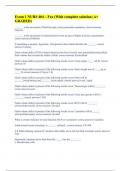 Popular
Popular
-
Exam 1 NURS 404 – Fox (With complete solution; A+ GRADED)
- Exam (elaborations) • 48 pages • 2024
- Available in package deal
-
- $13.99
- 1x sold
- + learn more
_______ is the movement of fluid through a semi-permeable membrane. correct answers Osmosis _______ is the movement of solutes/particles from an area of higher to lesser concentration. correct answers Diffusion If something is isotonic, hypotonic, or hypertonic these labels describe the _______. correct answers Tonicity Fluid volume deficit (FVD or hypovolemia) is the loss of (circle one) intracellular/extracellular fluid volume that exceeds the intake of fluid. correct answers Extracel...
 Popular
Popular
-
Test Bank for Huether and McCance's Understanding Pathophysiology, Canadian Edition, 2nd Edition by Kelly Power, Stephanie Zettel, , Mohamed Toufic El-Hussein
- Exam (elaborations) • 370 pages • 2024 Popular
-
- $46.25
- 1x sold
- + learn more
Test Bank for Huether and McCance's Understanding Pathophysiology, Canadian Edition, 2nd Edition by Kelly Power, Stephanie Zettel, , Mohamed Toufic El-Hussein Table of Contents PART ONE: BASIC CONCEPTS OF PATHOPHYSIOLOGY Unit 1: The Cell 1. Cellular Biology 2. Genes and Genetic Diseases 3. Epigenetics and Disease 4. Altered Cellular and Tissue Biology 5. Fluids and Electrolytes, Acids and Bases Unit 2: Mechanisms of Self-Defense 6. Innate Immunity: Inflammation and Wound Healing 7...

-
Exam 1: PNR202 / PNR 202 (Latest 2024 / 2025 Update) Intravenous Therapy | Questions and Verified Answers | 100% Correct | Grade A - Fortis
- Exam (elaborations) • 37 pages • 2024
- Available in package deal
-
- $7.99
- + learn more
Exam 1: PNR202 / PNR 202 (Latest 2024 / 2025 Update) Intravenous Therapy | Questions and Verified Answers | 100% Correct | Grade A - Fortis Question: How often do you change peripheral IV's? Answer: every 48-72 hours *according to policy* Question: (T/F): You should check your facility policy for LPN scope when dealing with PICC lines Answer: True Question: Central IV lines are usually located in which two veins? Answer: -subclavian vein -jugular vein Questio...
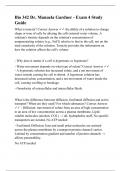
-
Bio 342 Dr. Manuela Gardner - Exam 4 Study Guide
- Exam (elaborations) • 19 pages • 2024
-
- $13.99
- + learn more
What is tonicity? Correct Answer the ability of a solution to change shape or tone of cells by altering the cells internal water volume. A solution's tonicity depends on the solution's concentration of nonpenetrating solutes (e.g., NaCl) relative to that in the cell, not on the total osmolarity of the solution. Tonicity provides the information on how the solution affects the cell's volume - Why does it matter if a cell is hypertonic or hypotonic? - Water movement depends on what type of...
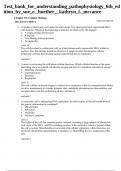
-
Test_bank_for_understanding_pathophysiology_6th_ed ition_by_sue_e._huether__kathryn_l._mccance
- Exam (elaborations) • 367 pages • 2024
-
- $16.49
- 1x sold
- + learn more
Chapter 01: Cellular Biology MULTIPLE CHOICE 1. A student is observing a cell under the microscope. It is observed to have supercoiled DNA with histones. Which of the following would also be observed by the student? a. A single circular chromosome b. A nucleus c. Free-floating nuclear material d. No organelles ANS: B The cell described is a eukaryotic cell, so it has histones and a supercoiled DNA within its nucleus; thus, the nucleus should be observed. A single circular chromosome ca...
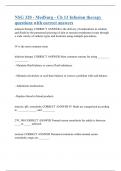
-
NSG 320 - MedSurg - Ch 13 Infusion therapy questions with correct answers
- Exam (elaborations) • 32 pages • 2023
- Available in package deal
-
- $14.49
- + learn more
infusion therapy CORRECT ANSWER is the delivery of medications in solution and fluids by the parenteral (piercing of skin or mucous membranes) route through a wide variety of catheter types and locations using multiple procedures. IV is the most common route infusion therapy CORRECT ANSWER Most common reasons for using ________ _________: - Maintain fluid balance or correct fluid imbalance - Maintain electrolyte or acid-base balance or correct a problem with said balance - Administe...

-
Med Surg Ch 11 - Fluid & Electrolyte questions with correct answers
- Exam (elaborations) • 29 pages • 2023
- Available in package deal
-
- $16.49
- + learn more
1. What immediate response does the nurse expect as a result of infusing 1 liter of an isotonic intravenous solution into a client over a 3-hour time period if urine output remains at 100 mL per hour? a. Extracellular fluid (ECF) osmolarity increases; body weight increases. b. Extracellular fluid (ECF) osmolarity decreases; body weight decreases. c. Extracellular fluid (ECF) osmolarity is unchanged; body weight increases. d. Extracellular fluid (ECF) osmolarity is unchanged; body weight de...
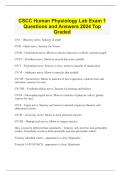
-
CSCC Human Physiology Lab Exam 1 Questions and Answers 2024 Top Graded
- Exam (elaborations) • 6 pages • 2024
-
- $12.99
- + learn more
CN I - Olfactory nerve, Sensory of smell CN II - Optic nerve, Sensory for Vision CN III - Oculomotor nerve, Motor to muscles that move eyeball, constricts pupil CN IV - Trochlear nerve, Motor to muscle that move eyeball CN V - Trigeminal nerve, Sensory to face, motor to muscles of mastication CN VI - Abducens nerve, Motor to muscles that eyeball CN VII - Facial nerve, Motor to muscles of face expression, controls tears and salivation, sensory for taste CN VIII - Vestibulocoh...
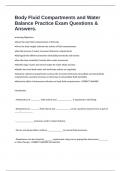
-
Body Fluid Compartments and Water Balance Practice Exam Questions & Answers.
- Exam (elaborations) • 34 pages • 2024
- Available in package deal
-
- $13.49
- + learn more
Body Fluid Compartments and Water Balance Practice Exam Questions & Answers. •Learning Objectives •Name the main fluid compartments of the body •Given the body weight estimate the volume of fluid compartments •Describe process of water movement between compartments •Distinguish the difference between Osmolality/osmolarity and tonicity •Describe how osmolality/ tonicity alters water movement •Identify major routes and normal ranges for water intake and loss •Explain how ...
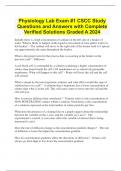
-
Physiology Lab Exam #1 CSCC Study Questions and Answers with Complete Verified Solutions Graded A 2024
- Exam (elaborations) • 12 pages • 2024
-
- $14.99
- + learn more
Initially there is a high concentration of sodium on the left side of a beaker of water. What is likely to happen (with regard to movement of ions and/or water) in this beaker? - The sodium will move to the right side of the beaker until it is spread out approximately the same throughout the beaker. What is the proper term for the process that is occurring in the beaker on the previous card? - Diffusion A red blood cell is surrounded by a solution containing a higher concentration of solut...
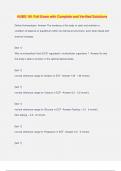
-
HUBS 191 Full Exam with Complete and Verified Solutions
- Exam (elaborations) • 22 pages • 2024
- Available in package deal
-
- $12.49
- + learn more
HUBS 191 Full Exam with Complete and Verified Solutions Define Homeostasis -Answer-The tendency of the body to seek and maintain a condition of balance or equilibrium within its internal environment, even when faced with external changes [lect 1] Why is extracellular fluid (ECF) regulated in multicellular organisms ? -Answer-So that the body is able to function in the optimal desired state. [lect 1] normal reference range for Sodium in ECF -Answer-135 - 145 mmol/L [lect 1] normal refer...

Did you know that on average a seller on Stuvia earns $82 per month selling study resources? Hmm, hint, hint. Discover all about earning on Stuvia


